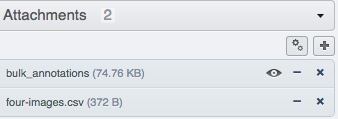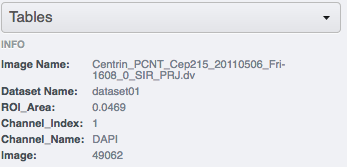Import metadata using the Populate Metadata script in OMERO.web
Description
This chapter will show how to import metadata starting from a local CSV file and ending with OMERO.tables on Images or wells using the server-side script Populate Metadata in OMERO.web. See also the workflow described in Import metadata using the Command Line Interface (CLI) which will give you more possibilities, such as Key-Value Pairs creation, but which is using Command Line Interface (CLI). The workflow described here is using only graphical user interface elements.
This action is typically done after a successful import of Images.
We will show:
- How to import metadata from local CSV file in a bulk manner and turn them into OMERO.tables on
How to create or adjust a local CSV file containing metadata for creation of OMERO.tables containing numbers and text.
Resources
Annotation CSV files define the content of OMERO.tables for each image or each well.
omero-metadataplugin (necessary for having full set of features inPopulate Metadatascript).
Setup
omero-metadata plugin installation
Note
For the best experience, the omero-metadata plugin should be installed on your OMERO.server. The Populate Metadata script tries to reuse the code of the omero-metadata plugin. If the plugin is not found on the server, the Populate Metadata script falls back on a deprecated code, with limited set of features. The omero-metadata plugin installation is typically done by the administrator of the OMERO.server.
In your OMERO.server environment, go to the environment where you installed your OMERO.cli as specified under - CLI installation.
Activate the virtual environment.
Run:
$ pip install omero-metadata
Populate Metadata script
No explicit installation necessary, shipped with the OMERO.server.
Step-by-step
Project/Dataset/Image
Log in to OMERO.web, create a new Dataset and copy into it four Images, preferably Images which have no OMERO.tables on them. Note the name of the Images you are copying in.
Download
four-images.csv. Open the CSV file in Excel and edit the name of the Images in the first column to match the names of the Images you copied into your Dataset in the previous step. Also, edit the name of the Dataset in the second column to match the name of your Dataset in OMERO.web. Save the file locally as CSV.(Optional) In your OMERO.web, upload the CSV file you just saved and attach it onto the Dataset you created previously. Alternatively, you can skip this step, and point the
Populate Metadatascript to the local CSV, as explained below.Select the Dataset you created. Find the script icon
 above the central pane, expand it and find the
above the central pane, expand it and find the Import scriptssection. In there, select thePopulate metadatascript which will launch the script dialog.If you did not attach the CSV to the Dataset, you can now click on the
Browsebutton and select the CSV from your local machine.Click
OKto run the script, and wait for it to show as complete in theActivitiespanel in the top-right corner above the central pane.Click again onto the Dataset in the left-hand pane to refresh and observe that there is a new Attachment in the right hand pane under “Attachments” harmonica, named
bulk_annotations.Click on single Images inside the Dataset and observe that in the “Tables” harmonica in the right-hand pane there are new values coming originally from your edited CSV.
Screen/Plate/Well
Find a Plate inside a Screen in OMERO.web which has no OMERO.tables on its Wells.
Download
simple-screen.csv. Open the CSV file in Excel and edit the name of the wells in the first column to match the names of the wells in your Plate from the previous step. Also, edit the name of the Plate in the second column to match the name of your Plate in OMERO.web. Save the file locally as CSV.(Optional) In your OMERO.web, upload the CSV file you just saved and attach it onto the Screen containing the Plate you created previously. Alternatively, you can skip this step, and point the
Populate Metadatascript to the local CSV, as explained below.Select the Screen you identified above. Find the script icon
 above the central pane, expand it and find the
above the central pane, expand it and find the Import scriptssection. In there, select thePopulate metadatascript which will launch the script dialog.If you did not attach the CSV to the Screen, you can now click on the
Browsebutton and select the CSV from your local machine.Click
OKto run the script, and wait for it to show as complete in theActivitiespanel in the top-right corner above the central pane.Click again onto the Screen in the left-hand pane to refresh and observe that there is a new Attachment in the right hand pane under
Attachmentsharmonica, namedbulk_annotations.Click on single Wells inside the Plate under the Screen and observe that in the
Tablesharmonica in the right-hand pane there are new values coming originally from your edited CSV.
Create a metadata CSV
Download the
four-images.csv(for Images in Projects/Datasets) orsimple-screen.csv(for Wells in Screens/Plates) as templates to create your own CSV.Open the downloaded CSV file in Microsoft EXcel, but do not use
Importcommand in Excel, instead, either double-click on the file or use theOpencommand in Excel. Populate the values in the CSV using Microsoft Excel with your own numbers or text, possibly expanding the number of rows or columns as appropriate.Replace the
# header ...column types inside the templates with your own column types according to the content of your CSV: Follow the Note below for guidelines. Save the file as CSV in Microsoft Excel.
Note
The # header row is optional. If # header is not used, all column types are treated as String (i.e. text, not numbers) in OMERO.
The header abbreviations have following meaning:
d: DoubleColumn, for floating point numbers
l: LongColumn, for integer numbers
s: StringColumn, for text
b: BoolColumn, for true/false
plate, well, image, dataset, roi: to specify objects
If the target is a Project, the CSV file needs to specify Dataset Name and Image Name. If the target is a Dataset instead of a Project, the Dataset Name column is not needed.
If the target is a Screen, the CSV file needs to specify Plate name and Well. If a # header is specified, column types must be well and plate. If the target is a Plate, the CSV file must not specify a Plate column, but it must specify the Well column.
Column names should not contain spaces if you want to be able to query by these columns.





